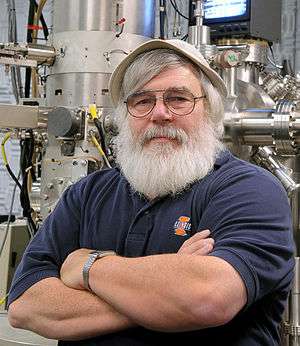Nestor J. Zaluzec

Nestor J. Zaluzec[1] is an American scientist and inventor who works at Argonne National Laboratory. He invented and patented the Scanning Confocal Electron Microscope.[2][3][4][5] and the π Steradian Transmission X-ray Detector for Electron-Optical Beam Lines and Microscopes.[6][7]
Career
A Fellow of both Oak Ridge National Laboratory (ORNL) as well as the Computational Institute of the University of Chicago, Zaluzec has and continues to hold the tripartite role of Senior Scientist, Educator and Inventor at Argonne. As an innovator, his research includes development state-of-the art of instrumentation and techniques for atomic resolution x-ray & electron spectroscopy, and electron microscopy. In addition to creating tools for science, as a researcher he also uses these bleeding edge technologies to study vexing problems in technologically important materials. Over the last quarter of a century, his work has included studies in the areas of: structural phase transformations in metals, radiation damage in alloys, ceramic oxides for geologic immobilization of nuclear waste materials, elemental segregation in semiconductor devices, to genetically engineered proteins for creation of two dimensional biological templates for magnetic nanoarrays. He was one of the earliest to realize the potential impact of the Internet on science and established the TelePresence Microscopy Collaboratory,[8] which has served as a model for outreach to both the scientific and education communities providing unencumbered access to scientific resources. In addition to his roles as an adjunct professor at various Illinois universities, he also strives to engage the next generation of scientists through his work with the Illinois Junior Academy of Science, where he continues to interact on a one-to-one basis with middle and high school students.
Electron microscopy
Zaluzec has made wide ranging contributions to the field of electron microscopy and microanalysis beginning with his seminal work on quantitative x-ray and electron spectroscopy, which has been disseminated throughout the scientific and academic communities through hundreds of lectures, short courses and/or seminars at scientific conferences and meetings around the globe. He developed Lorentz STEM imaging, High Angular Resolution Electron Channeling X-ray Spectroscopy (HARECXS), High Angular Resolution Electron Channeling Electron Spectroscopy (HARECES), Position Resolved Diffraction, as well as his invention of the scanning confocal electron microscope and the π steradian Transmission X-ray Detector, for which he was given the R&D 100 Awards in 2003 and 2010 respectively.
His professional leadership, includes the Midwest Microscopy and Microanalysis Society (MMMS)[9] and numerous positions in the Microscopy Society of America (MSA) to which was elected President in 2009.[10] He is the recipient of numerous awards from professional societies such as the August Köhler Award from the State Microscopical Society of Illinois, Distinguished Service Awards from the MSA and the Australian Microscopy Society, Member of the Year Award from the Midwest Society of Electron Microscopists, Presidential Citation from the Australian Society for Electron Microscopy, the Science Digest "One of America's 100 Brightest Scientists" Award and two R&D 100 Awards. He has been elected as a Fellow of ORNL, the Microscopy Society of America and the Computational Institute of the University of Chicago.
He established and was the first Director of the Electron Microscopy Center at Argonne National Laboratory,[11] and has held various Adjunct Professorial Appointments at Illinois Universities (IIT, UIUC, UIC, and NIU) and is a member of 6 professional microscopy societies (MSA, Microbeam Analysis Society, Microscopical Society of Canada, Australian Microscopy and Microanalysis Society, European Microscopy Society, MMMS), and has served on 5 national committees. Zaluzec has also served the professional community of fellow scientists in a number of other ways as a volunteer (1980–present). For the last two decades, he has operated the Microscopy Listserver[12] a communication form that links over three thousand microscopists and microanalysts worldwide.
References
- ↑ Argonne National Laboratory: Nestor Zaluzec, biography/resumé
- ↑ N.J. Zaluzec, US Patent # 6,548,810, 2003
- ↑ N.J. Zaluzec (2003). "The Scanning Confocal Electron Microscope" (PDF). Microsc. Today. 6: 8.
- ↑ N.J. Zaluzec (2007). "Scanning Confocal Electron Microscopy". Microsc. Microanal. 13 (S02): 1560. doi:10.1017/S1431927607074004.
- ↑ S.P. Frigo; Z.H. Levine; N.J. Zaluzec (2002). "Submicron imaging of buried integrated circuit structures using scanning confocal electron microscopy". Appl. Phys. Lett. 81 (11): 2112. doi:10.1063/1.1506010.
- ↑ N.J. Zaluzec, US Patent Application # 61,317,847, 2009
- ↑ N.J. Zaluzec (2009). "Innovative Instrumentation for Analysis of Nanoparticles: The π Steradian Detector". Microsc. Today. 17 (04): 56–59. doi:10.1017/S1551929509000224.
- ↑ TelePresence Microscopy Collaboratory website
- ↑ MMMS Home Page
- ↑ MSA website
- ↑ Argonne National Laboratory Electron Microscopy Center
- ↑ The Microscopy ListServer